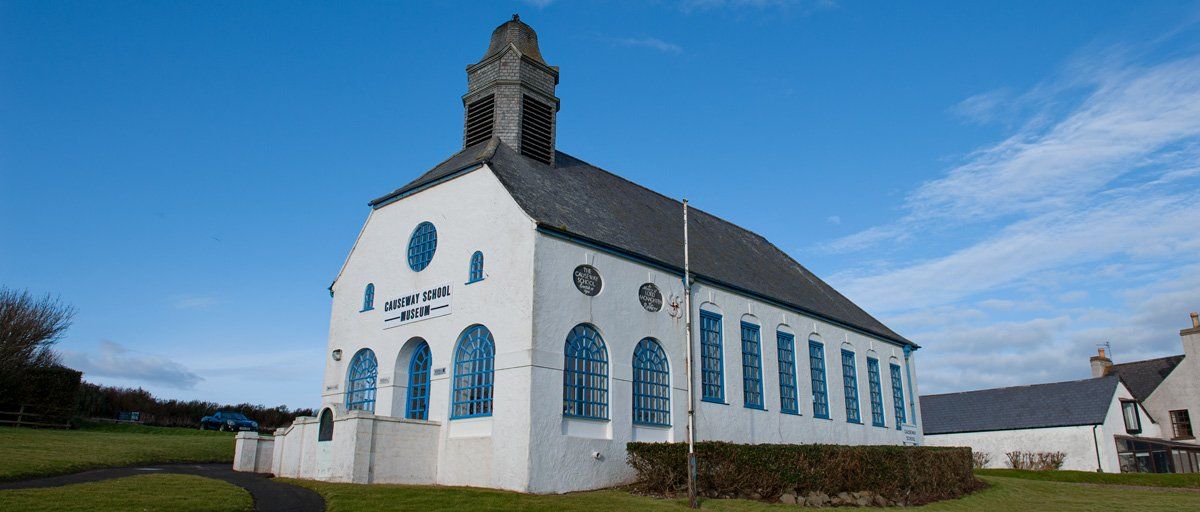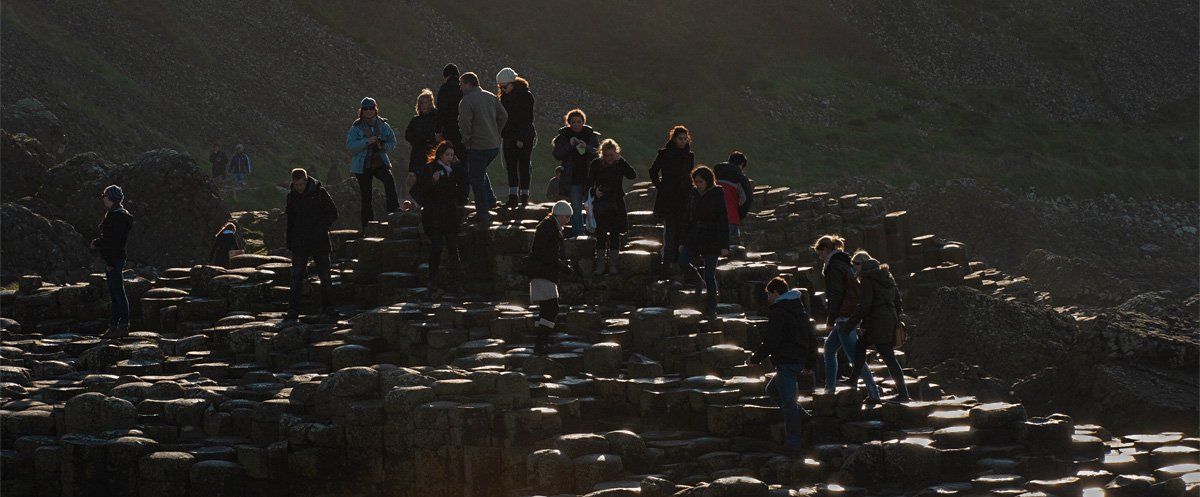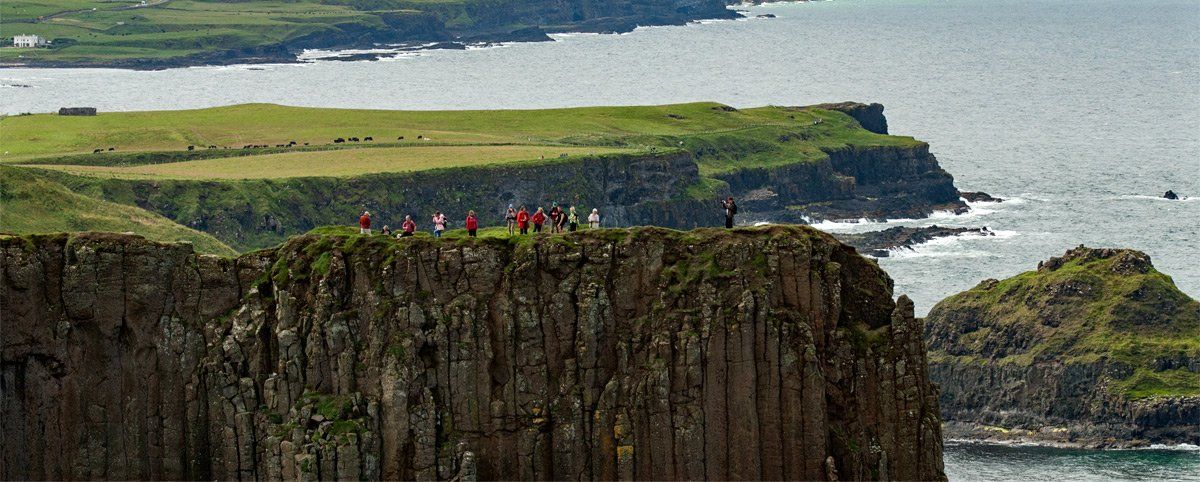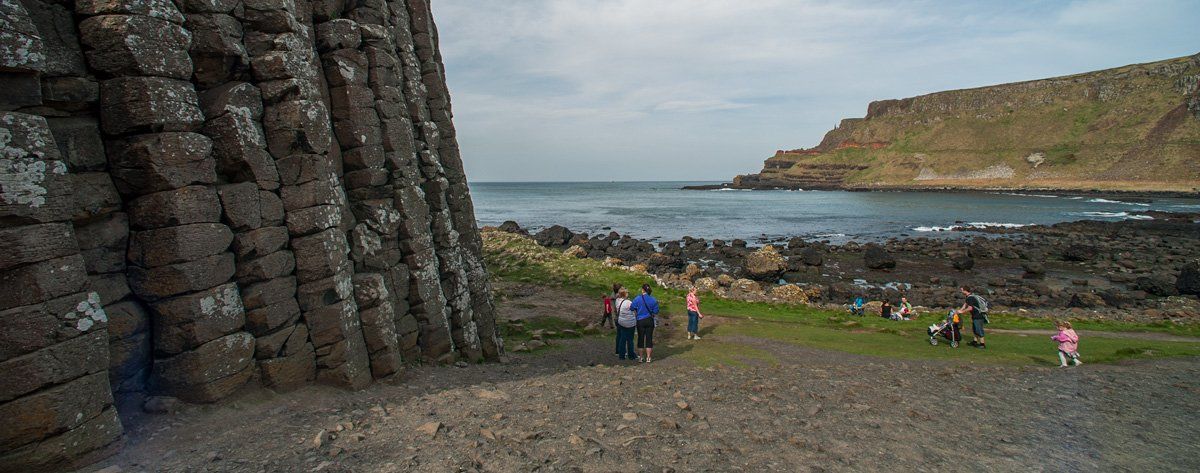The Causeway School opened in 1915 and closed in 1962, it was built by the Macnaghten family in memory of Baron Macnaghten of Runkerry to replaced the original Causeway School which had been in existence from the middle of the nineteenth century. That school existed where the Nook restaurant and wine bar is today. The Causeway School was designed by Clough Williams-Ellis who visited these shores on several occasions, he is renowned for designing and building the picturesque and unique village of Portmeirion in Wales which featured as a backdrop to the 1960's television series 'The Prisoner'. He also designed the Bushmills Memorial School (Old Grammar School) situated on the Priestland Road in Bushmills. Other designs by Clough Williams-Ellis can be seen in the 'unique' conservation village of Cushendun.
The Causeway School originally had an open porch which was eventually glazed. It was fine during summer but when the prevailing winds of winter came proved less practical for pupils. Rosamund Praeger from Hollywood, County Down produced the sculpture inside the porch which depict the story of the Children of Lir and shows Finnoula in human form sheltering with her swan siblings during their exile on the Sea of Moyle. More work is located on the wall outside the entrance, a beautiful bronze relief sculpture of a small girl.
The Causeway School is currently closed, the Education & Library Board terminated their provision of an educational experience here for Northern Ireland pupils and the general public during the main visitor season, the reason cited was budgets and sustainability, ironically, on a site adjacent to a Visitor Centre which receives over one million visitors per year. One of the teacher's who taught at the old and new school was Daniel McConaghy, he was born in 1865, the second son of John McConaghy and Mary Jane Redmond. The family home, Warren View was adjacent to the Causeway Memorial School, just a field or two away from the headland which plunges dramatically down to the Giant’s Causeway. It was here that he met his wife, Margaret Ann Graham who came from Dumfrieshire.
She had trained in haute-couture dressmaking and hairdressing, in 1890 she became the maid for Lord Macnaughten's six daughters and came from London to serve them. When she made her first appearance in the area following the Macnaghten ladies as they filed into the church, the local commentary praised her poise, style and lovely thick, auburn hair. The Macnaghten's used to host cultural evenings at Runkerry House and Daniel McConaghy, the local schoolmaster, would attend with his violin. Margaret Graham first saw him there, and was quite taken with him. The story goes that she visited the Wishing Chair at the Giant’s Causeway to make a very special wish - that one day she would be his wife. Love blossomed, and they were married at Billy Parish Church in 1897.
Daniel and Margaret lived in the Teacher’s Residence at Ardihannon, now demolished, which was only a hundred yards from the school gates. Here they raised eight children, but sadly lost a daughter, Ellen Mary, who was not quite ten. She died in April 1917, during the heaviest snowfall for many years, the horse-drawn hearse was unable to travel out from Coleraine or Ballymoney. In an act which is testimony to the spirit of the community and the love extended to the family, local friends and farmer's dug a path through the drifts from the Giant’s Causeway to Billy Parish Church, a distance of three miles or more, so that her little coffin could be taken by pony and trap for burial.
Daniel McConaghy trained at the Church of Ireland Teacher Training College in Dublin, and also studied Horticulture at Glasnevin near Dublin. He began teaching in 1887, and taught at the school for 43 years, moving up from the Old National School (which is now The Nook) in 1915 to become principal of the new Causeway Memorial School, he served there until he retired in 1930. Even in retirement, he continued to be known affectionately as the “Master”. Writing of her high regard for him, one former pupil said that she could fill a page telling of all the good things about the Master. He was a person of quiet integrity and his life and example demonstrated kindliness toward all men and a deeply held faith in the sovereignty and goodness of God.
The McConaghys of Warren View were people of faith – they loved books and were also musical. Daniel’s father trained a Temperance Band in their home, and Daniel could play piano, violin and the flute well. He taught the children at school to sing songs and hymns in four-part harmony, and at the end of the school day, he played the flute or fiddle for them to drill and dance to. He was gifted artistically too, and undoubtedly would have shared his love of drawing with his students. The Causeway School was said to have been one of the most progressive in the area. Daniel McConaghy’s enthusiasm for teaching scientific ideas and his love of horticulture, and bee-keeping, created a diverse and hands-on learning experience for his students.
Margaret McConaghy would make big pots of broth, full of all kinds of vegetables to feed her own children when they came down at lunchtime to the schoolhouse. They had plates of broth and “pieces” – thick slices of buttered bread. In those days many children had to come to school without even a piece. Those who found their way down to the house were never turned away from having a share of the master’s humble fare. Some of the children came barefooted and tattered and sometimes Margaret, who was an expert seamstress, adept at cutting down old clothes to make do and mend, would take time to make a garment for an especially needy child.
The McConaghy family has long been connected with the Giant’s Causeway. Their generations have farmed the land, grazed sheep and cattle, and collected and dried kelp there. Some from amongst them ventured out with the waves of emigrants who sailed to America and to Australia during the nineteenth century. Sad letters from Australia tell of a difficult life, and a great longing for homeland, and speak of precious connections with fellow immigrants from other North Antrim families. One of the McConaghy’s who was fortunate enough to fulfill his hopes of returning from Australia was Daniel’s older brother, John, who later became land steward at Runkerry for Lord Macnaghten.
Warren View was a popular guest house in the 1880s and comments from well-pleased patrons in the old visitor’s book span three decades and attest to the family’s warm hospitality, good food, and comfortable accommodations – a home from home, amidst the beauty of the natural surroundings, that welcomed visitors back summer after summer, and from as far afield as the United States. The family also had a ‘tent’ - a little shop for souvenirs and refreshments along the path that led down to the Causeway. In 1896 Daniel’s father opened the Giant’s Causeway Post Office in the front parlour of Warren View, Ulster’s tiniest postal district was created complete with its own special postmark.
The Giant’s Causeway postmark was much in demand by stamp collectors and sought by tourists who visited from all over the world. With potted geraniums on the window sill and well-worn floorboards, a warm wooden counter cluttered with nostalgic postal paraphernalia - the gleaming brass scale with its assortment of weights, ledgers, files and a wall of wooden drawers, an old fashioned black telephone, walls papered with posters and notices, and lighting provided flickering oil lamps it was, until it close, a charming reminder of a bygone era. Family members from three generations served as Post Master at the Giant’s Causeway Post Office until it closed with the retirement of Daniel’s daughter, Maud McConaghy in 1975.













